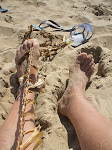Having done some experiments and decided that I want to use a particular material for whatever it is that I am making, I then select from my boxes and sacks of collected materials the actual materials for the task. As I don't buy materials there needs to be enough for whatever job I have planned for it but, this is very difficult to guage accurately so, usually, I just hope and trust that there will be enough. The astonishing thing is, that nearly every time it works to such a fine degree that I find myself scrabbling in the bottom of a sack or a box to root out the last few centimetres of whatever it is to add the final touches, and it happened again this week.
My initial idea was to use either tetra paks or corrugated cardboard in the same fashion as the splints, that is, to weave panels and then nail the completed panels to the back and seat. But weaving a panel and attaching it to something never excites me as much as working 3 dimensionally and as I was restoring the chair for my own use I saw no reason why I should bore myself whilst doing it. In addition I find it hard to trust nails now after too many experiences of splitting wood by using the wrong nail for the job, and the chair was already splatter-gunned with nail holes. So, I abandoned the panel idea. Weaving over the structure with tetra pak and cardboard strips was the next thing I tried, but neither felt strong enough and the curved shape didn't lend itself to this type of weave.
 There is a sack of used polypropylene strapping tape in my studio. It is the remains of a large amount of waste tape that I collected some years ago from a packaging company in London for a public commission that I was working on at the time .The tape came wrapped around the pallets of cardboard they imported and every day of the week they threw out one or two skips full of it. The skips were emptied into a barge on the Thames that floated downstream to the implausible sounding Mucking landfill site in Essex where this still perfectly functional tape was interred along with all the rest of Londons' so called waste. Something that struck me when I collected the material from the company was that the workers there obviously sensed that the material was not really 'waste' because they often bundled it into neat little hanks before throwing it into the skip, even though they were not asked to do this.
There is a sack of used polypropylene strapping tape in my studio. It is the remains of a large amount of waste tape that I collected some years ago from a packaging company in London for a public commission that I was working on at the time .The tape came wrapped around the pallets of cardboard they imported and every day of the week they threw out one or two skips full of it. The skips were emptied into a barge on the Thames that floated downstream to the implausible sounding Mucking landfill site in Essex where this still perfectly functional tape was interred along with all the rest of Londons' so called waste. Something that struck me when I collected the material from the company was that the workers there obviously sensed that the material was not really 'waste' because they often bundled it into neat little hanks before throwing it into the skip, even though they were not asked to do this.I have now used most of the colours that I like and had been left with a large amount of very stiff, transclucent green tape that, until now, I have had very little use for as I did not find it particularly attractive or easy to work with. But after a cursory rummage in the sack I realised that its moment had arrived (is this another law - when the right job comes along the material ceases to be unattractive?) and the chair has been woven with it and, as usual, I have been left with barely a metre of tape!




















 Subsequent research revealed that the Eyot had been planted and cultivated for basket making between about 1800 and 1935 when the last person granted a right to cut the osiers went out of business and the island was subsequently taken over by the local council. The demand for baskets in the area had come from the numerous market gardens in the area that needed containers to transport their produce downstream to the markets of the city of
Subsequent research revealed that the Eyot had been planted and cultivated for basket making between about 1800 and 1935 when the last person granted a right to cut the osiers went out of business and the island was subsequently taken over by the local council. The demand for baskets in the area had come from the numerous market gardens in the area that needed containers to transport their produce downstream to the markets of the city of
















 It struck me then how important these demonstrations are in terms of teaching the general public about the quantity and quality of the work that goes into making a basket. Those that had watched this man would have had no doubt that it was worth every cent of the 31€ he was asking for it.
It struck me then how important these demonstrations are in terms of teaching the general public about the quantity and quality of the work that goes into making a basket. Those that had watched this man would have had no doubt that it was worth every cent of the 31€ he was asking for it.



